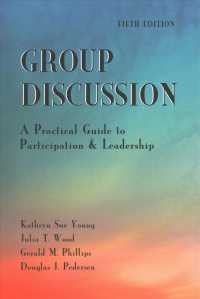Full Description
Dialogues represents argument not as a battle to be won, but as a process of dialogue and deliberation-the exchange of opinions and ideas-among people with different values and perspectives.
Part One contains succinct instruction on analyzing and developing arguments, including critical reading, source documentation, and analyzing visual arguments. Part Two, updated with many new readings addressing current issues, offers a diverse collection of provocative essays from both the popular and scholarly medium. The lucid, lively, and engaging writing addresses students as writers and thinkers, without overwhelming them with unnecessary jargon or theory.
Contents
Part One Strategies for Reading and Writing Arguments
Chapter1 Understanding Persuasion: Thinking Like a Negotiator
Argument
What Makes an Argument?
The Uses of Argument
Debate
Moving from Debate to Dialogue
Dialogue
Deliberation
Deborah Tannen, "Taking a 'War of Words' Too Literally"
Sample Arguments for Analysis
Michael Lewis, "The Case Against Tipping"
* Catherine Rampell, "A Generation of Slackers? Not So Much"
Exercises
Chapter 2 Reading Arguments: Thinking Like a Critic
Why Read Critically?
Preview the Reading
Skim the Reading
Sample Argument for Analysis
Henry Wechsler, "Binge Drinking Must Be Stopped"
Consider Your Own Experience
Annotate the Reading
"Binge Drinking Must Be Stopped"
Summarize the Reading
Analyze and Evaluate the Reading
Argue with the Reading
Create a Debate and Dialogue Between Two or More Readings
Sample Argument for Analysis
Froma Harrop, "Stop Babysitting College Students" (student essay)
Construct a Debate
Sample Arguments for Analysis
Kathryn Stewart and Corina Sole, "Letter to the Editor" from the Washington Post
James C. Carter, S. J., "Letter to the Editor" from the Times-Picayune
Deliberate About the Readings
Look for Logical Fallacies
Exercises
Chapter 3 Finding Arguments: Thinking Like a Writer
The Writing Process








